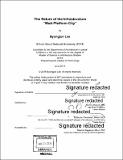The return of the infrastructure "Muti-Platform City"
Author(s)
Lee, Byongjun, S.M. Massachusetts Institute of Technology
DownloadFull printable version (19.13Mb)
Other Contributors
Massachusetts Institute of Technology. Department of Architecture.
Advisor
James Wescoat and Dennis M. Frenchman.
Terms of use
Metadata
Show full item recordAbstract
Cities, spaces that always coexist with the old and new, are similar to realms of production. Cities have complex layers of construction over time, including all types of transport infrastructure roads, railways, highways, etc. This infrastructure reflects the city's history and evolution. The thesis studies the impact of infrastructural interventions on the urban environment, especially in terms of its morphological changes during the 19th through the 21st centuries. By examining this impact, the thesis shows that there is an important causal relationship between technology, means of transportation, and infrastructure planning. The first half of the project is an analysis of the development of transport infrastructure in general and the evolution of city form. With this as a backdrop, the second half proposes a new urban transportation framework in an historic area of Boston suggesting ways to improve urban environments by introducing transport infrastructure that is more integrated into the urban fabric. More specifically, this section takes a close look at Bulfinch Triangle in Boston, which has had dramatic transport infrastructure changes. This small triangle-shaped area, created from landfill in 1825, underwent changes that essentially buried major infrastructure underground. While this minimized the impact of pollution, it also separated city life from the infrastructure below. This thesis proposes a shift in the relationship between the urban and pedestrian environment and a new, integrated transport system - that is, above ground and using new technologies.
Description
Thesis: S.M., Massachusetts Institute of Technology, Department of Architecture, 2016. Page 157 blank. Cataloged from PDF version of thesis. Includes bibliographical references (pages 143-147).
Date issued
2016Department
Massachusetts Institute of Technology. Department of ArchitecturePublisher
Massachusetts Institute of Technology
Keywords
Architecture.